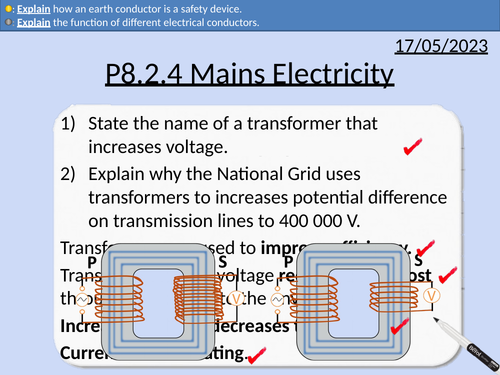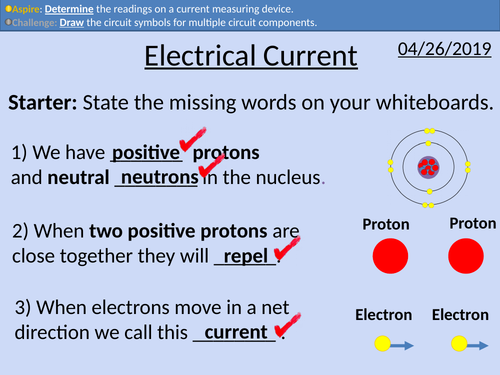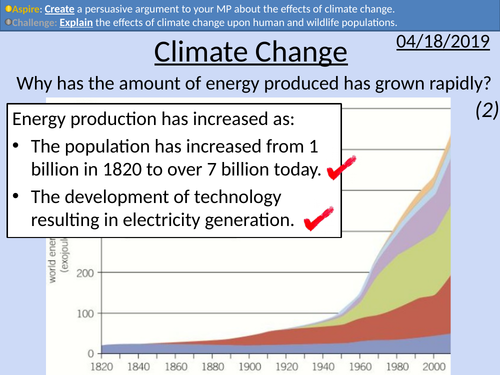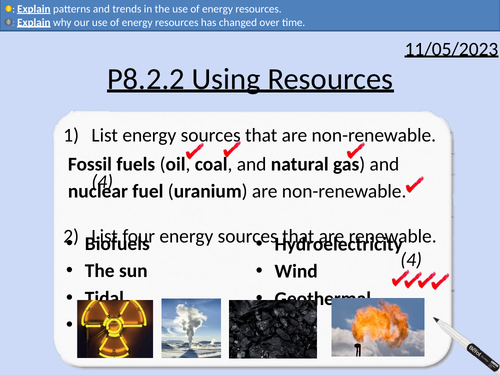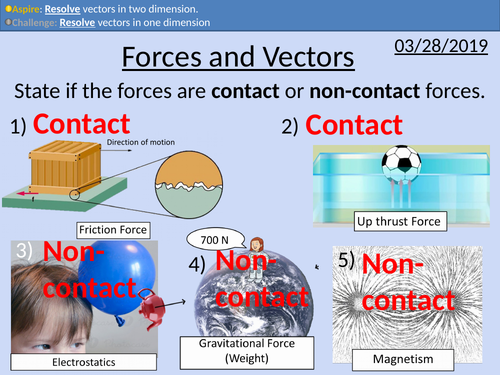496Uploads
163k+Views
70k+Downloads
All resources

GCSE Physics: Mains Electricity
This presentation covers OCR Gateway Physics 9-1 P8.2.4 Mains Electricity
This PowerPoint is a whole lessons included with student activities and animated answers.
Domestic Electrical Supply being 230 V, AC at 50 Hz.
Direct potential difference and alternating potential difference.
Reasons for insulation on wires.
Potential Difference between different conductors.
Function of the earth conductor.
Double insulation and no earth wire.
Reasons the live wire is dangerous.
Reasons why live to earth is dangerous.

GCSE Physics: The National Grid
This presentation covers OCR Gateway Physics 9-1 P8.2.3 The National Grid
This PowerPoint is a whole lessons included with student activities and animated answers.
Structure of the National Grid
Step-up and Step-down transformers
How transformers increase the efficiency of the National Grid
Number of turns and potential difference
Current and potential difference in primary and secondary coils

GCSE Physics: Electrical Resistance
This PowerPoint presentation with worked examples and student questions covers:
• Ohm’s law and units
• Proportionalities
• Resistance in series
• Rearranging equations
• Calculating resistance with ohm’s law

GCSE Physics: Constructing Circuits
This PowerPoint presentation with worked examples and student questions covers:
• Constructing Series Circuit
• Constructing Parallel Circuits
• Analysing results for Potential Difference
• Analysing results for Current
• Clear resource list, diagrams and photos to aid teaching.

GCSE Physics: Potential Difference
This PowerPoint presentation with worked examples and student questions covers:
• Modelling potential difference and current
• Circuit symbols and units
• Measuring potential difference
• Series and Parallel circuits

GCSE Physics: Electrical Current
This PowerPoint presentation with worked examples and student questions covers:
• Circuit symbols
• Conditions for current to flow
• Measuring current in series circuits
• Measuring current in parallel circuits.

GCSE Physics: Electricity and Subatomic Particles
This PowerPoint presentation with worked examples and student questions covers:
• Atoms and the particle model for solids, liquids and gases
• Subatomic particles and the property of charge
• Structure of a metal
• Explanations of the Van de Graff and Lightning.

GCSE Physics: Climate Change
This PowerPoint presentation with worked examples and student questions covers:
• Types of greenhouse gases – carbon dioxide, methane, nitrous oxide, and water vapour.
• Greenhouse effect with activity
• Class discussion on news report of effects of climate change
• Extended writing task with student friendly mark scheme and scaffolding
• Data analysis task
• Explanation of data collection of CO2 levels
Bundle

GCSE Physics: Physics on the move
This bundle of resources contains 12 lessons for OCR GCSE Physics: Physics on the move.
This is a perfect set of lessons to start your GCSE physics course in year 9 as each lesson builds from the last and doesn’t presuppose any other GCSE physics knowledge.
Scientific definitions from working scientifically
Maths skills and rearranging equations
Planning Experiments
All lessons have worked examples, questions for students, and plenary activities.

GCSE Physics: Energy Resources
This presentation covers OCR Gateway Physics 9-1 P8.2.2 Energy Resources
This PowerPoint is a whole lessons included with student activities and animated answers.
How use of energy resources have changed over time. (Biofuels, Fossil Fuels, Nuclear, Renewable).
How energy use has increased (increase population and development of technology)
Explain patterns and trends in the use of energy resources.
Fossil fuels are finite and will run out at current consumption levels.

GCSE Physics: Forces and Large Acclerations
This PowerPoint presentation with worked examples and student questions covers:
Road safety
Force and acceleration equations
How large forces produce dangerous accelerations

GCSE Physics: Balanced Forces
This PowerPoint presentation with worked examples and student questions covers:
Balancing forces with vectors
Accelerations and resultant forces

GCSE Physics: Forces and Vectors
This PowerPoint presentation with worked examples and student questions covers:
Vector addition in 1D
Vector addition in 2D
Resolving vectors

GCSE Physics: Introduction to Forces
This PowerPoint presentation with worked examples and student questions covers:
Contact and Non-contact forces
Forces and accelerations
Tug of war example

GCSE Physics: Acceleration Practical
This PowerPoint presentation with worked examples and student questions covers:
• Acceleration experiment protocol
• Ensuring results are reproducible and repeatable
Spotting and removing anomalies.
Rearranging equations

GCSE Physics: Acceleration - Planning an Experiment
This PowerPoint presentation with worked examples and student questions covers:
Choosing equipment with higher resolution
Planning an experiment to determine acceleration

GCSE Physics: The Acceleration Equation
This PowerPoint presentation with worked examples and student questions covers:
• Acceleration equation with units
• Speed-time graphs

GCSE Physics: Scientific Defintions and Speed Experiment
This PowerPoint presentation with worked examples and student questions covers:
• Definitions of accurate and precise
• Definition of resolution
• Definition of repeatable and reproducible
• Planning an experiment for determining speed

GCSE Physics: Speed Equation
This PowerPoint presentation with worked examples and student questions covers:
• The speed equation and units
• Rearranging Equations
• The skill of estimating

GCSE Physics: Introduciton to Physics
This presentation covers diversity in physics both within the physics community and also with the breadth of what is classified as physics. It contains class activities, a video, and also a research task which could be completed as a class task or as set homework.

